The Samsung Galaxy S6 and S6 edge Review
by Joshua Ho on April 17, 2015 9:00 AM EST- Posted in
- Smartphones
- Samsung
- Mobile
- Galaxy S6
- Galaxy S6 Edge
NAND Performance: The First UFS Phone
Storage performance is often a critical area for user performance, as applications cannot be cached in RAM at every possible moment. Camera performance is also often limited by storage performance as RAM buffers can only do so much to maintain performance before it’s necessary to commit photos to non-volatile storage.
However due to the memory hierarchy to some extent, storage performance is often hard to notice once it’s at a point where things are “good enough”. Unfortunately, in some cases we can see OEMs failing to include sufficiently performant solid-state storage, which can be a major pain point in the user experience when random read/write performance is low enough that there are noticeable IO pauses as the system has to wait for data to be loaded from storage.
The Samsung Galaxy S6 family is the first shipping implementation of UFS (Universal Flash Storage) 2.0 standard, which makes the internal storage model less like an SD card in nature. When comparing the eMMC 5.1 standard to the UFS 2.0 standard, we see a move from a the 400 MB/s maximum of the eMMC 5.1 standard with HS400 physical link interface to MIPI M-PHY, which allows for a theoretical maximum of around 720 MB/s and should be more efficient in transmitting data than the current eMMC standard. In addition, UFS makes it possible to do full duplex communication, which means that reads and writes can happen simultaneously. There's also a command queue, which helps to avoid inefficiencies that could arise from waiting for commands once a command has been processed by the storage controller, and utilizes the SCSI protocol to facilitate these new features at the interface level.
As for the Galaxy S6 itself, the UFS implementation Samsung is using is Samsung developed. Samsung's current implementation only supports up to 300 MB/s (or 2.4 Gbps) transfer rates as a theoretical maximum, so from an interface perspective it's still not reaching the full capabilities of the standard. Though even at a cap of 300MB/sec, it still stands to be a significant improvement over typical eMMC solutions.
Finally, on a technical note, the 32GB models are of the model KLUBG4G1BD-E0B1 with a maximum queue depth of 16.
In order to test storage performance, we use Androbench with some custom settings to get a reasonable idea of performance in this area, although this test isn’t an exhaustive examination of storage performance by any means.
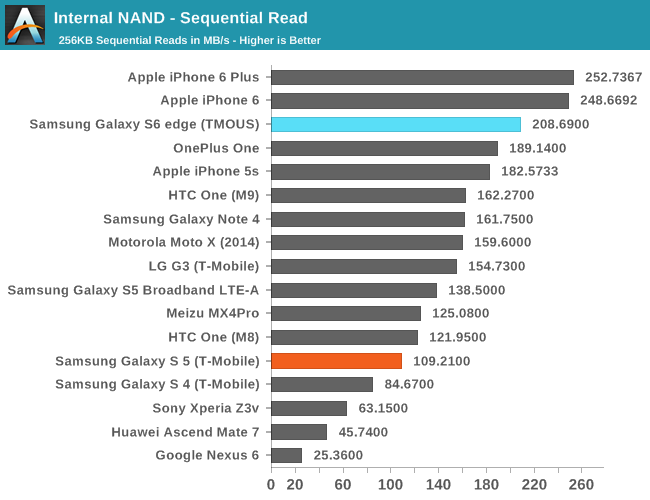
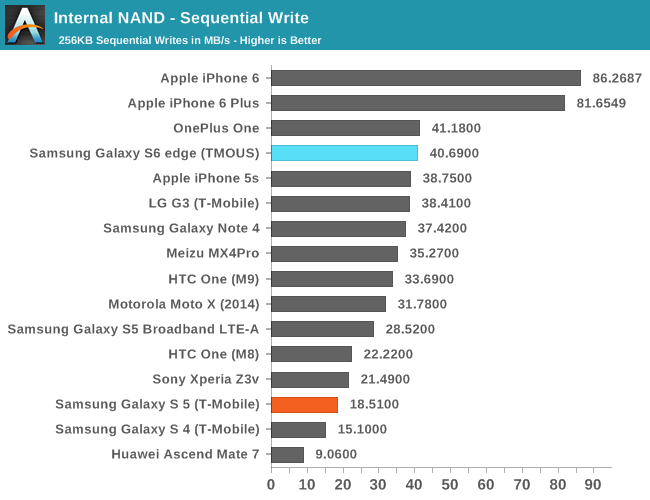
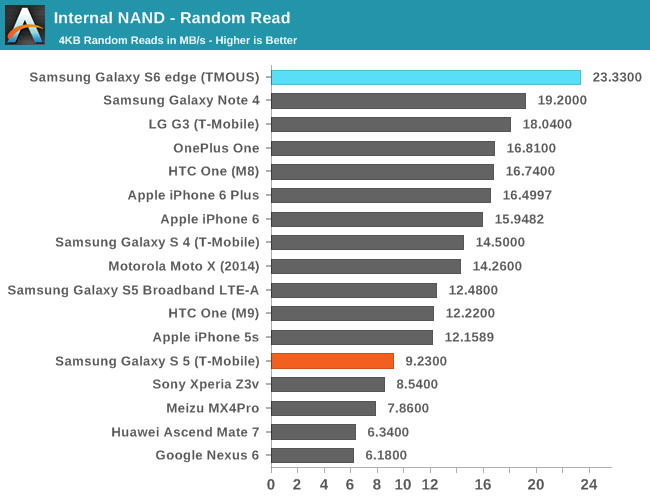
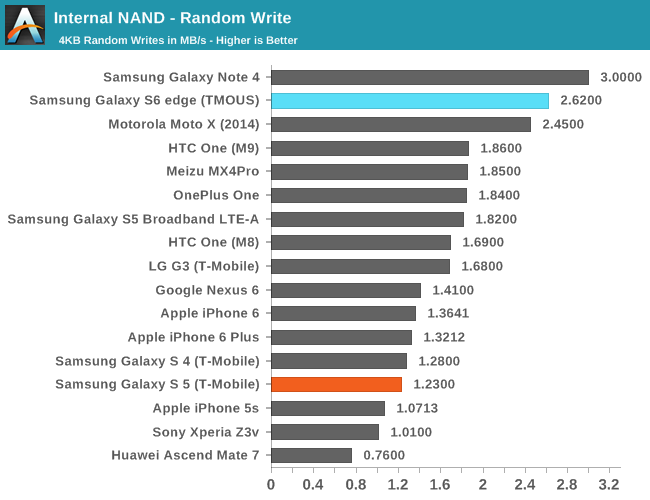
The Galaxy S6 performs rather impressively in our standard storage test, but not as fast as one might have hoped. This is due to the nature of the Androbench 3.6 test, which only tests a single IO thread, which won’t use the UFS storage of the Galaxy S6 to its full extent. In order to see the kind of difference that UFS really makes, I ran the same test again on Androbench 4.x, which does support multiple IO threads. However, as our iOS storage test and Androbench 3.6 don’t support more than a single IO thread we will continue to present both results for now.
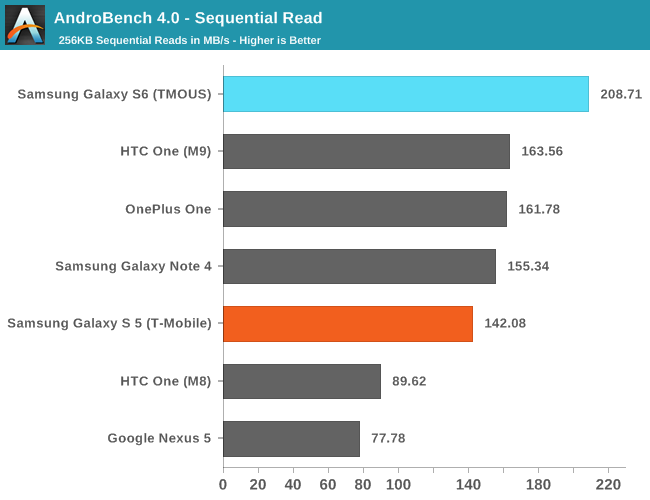
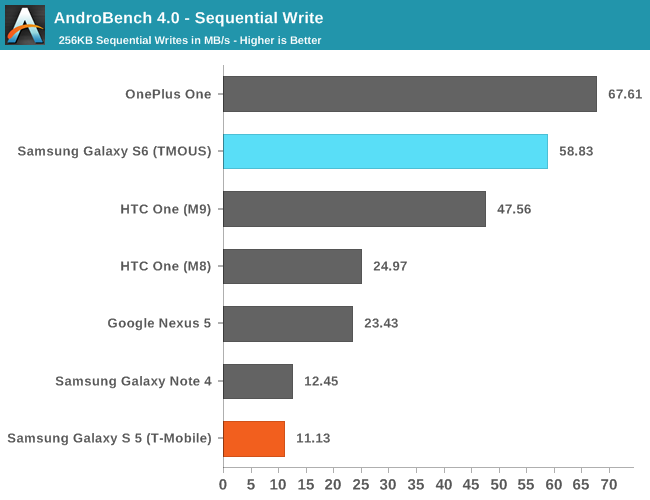
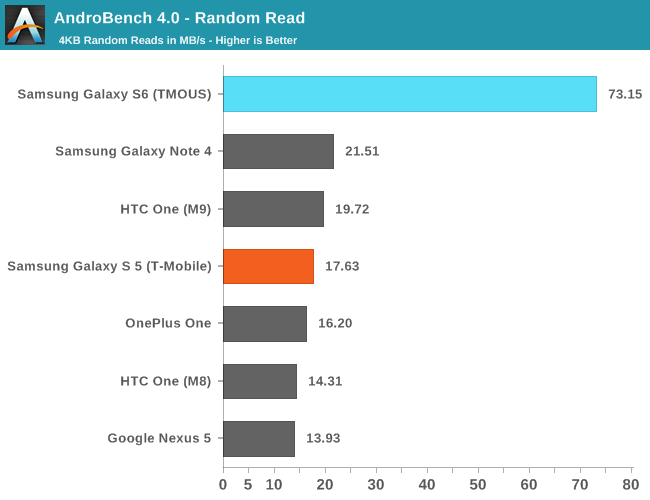
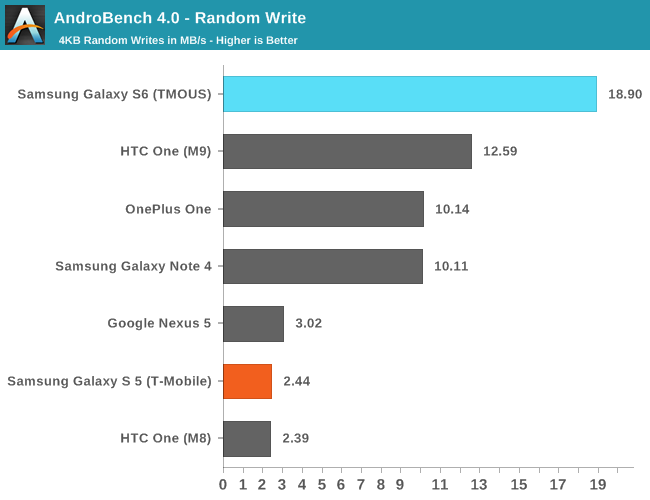
Overall, there are some immense benefits in storage performance here, especially in random IO performance. The Galaxy S6 has some of the fastest storage available in a phone today as far as I can tell given that this is basically a pure MLC solution, and shouldn’t have any real issue with storage performance holding back the rest of the phone over the course of 1-3 years as long as a reasonable amount of free space is kept to allow efficient storage management.


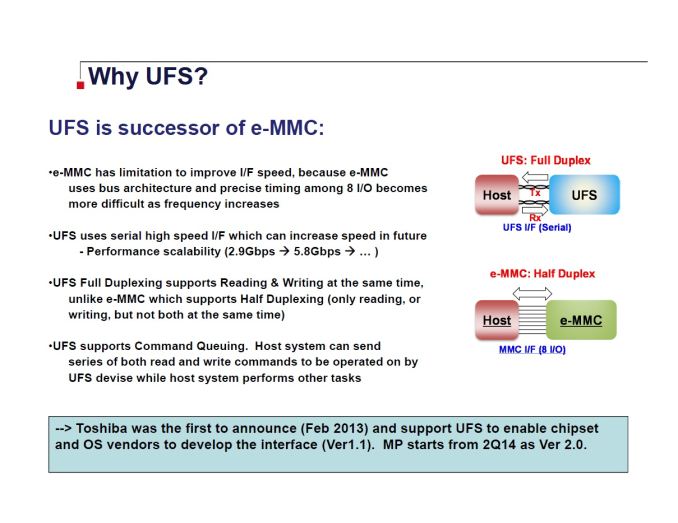








306 Comments
View All Comments
hlovatt - Saturday, April 18, 2015 - link
Firstly, great review. Love all the detail and care taken in obtaining the results.I am glad to see the changes Samsung have made. The S4 and S5 were really oh hum phones, not deserving the flagship monicker. This time they have produced something that will challenge Apple, HTC, etc.
melgross - Saturday, April 18, 2015 - link
$45 isn't all that much. You would save $15 by doing it yourself. So you will need tools to pry the case apart after you've softened the glue using a hairdryer. How do you intend to put it back together?xenol - Friday, April 17, 2015 - link
I just don't find myself needing an SD card slot, if only because I don't really fill my phone up anyway. I'm really wondering what other people fill their phones up with in order to need an SD card slot. I was under the impression that music is just lifted off internet radios and videos from YouTube or some other service (and if they want to watch a lengthy movie, they'll add it in when they want to).I don't know, maybe I'm just the kind of person who doesn't mind managing data and don't have a lot to begin with on the phone.
esterhasz - Friday, April 17, 2015 - link
I have a lot of music on my phone and videos for the kid. Having to pay such a premium for a 64gb version is hard to swallow when sd cards are really cheap.SkyBill40 - Friday, April 17, 2015 - link
Agreed. Like you, I've got a lot of music on my phone and it's all on an SD card.I'm upgrade eligible at any time from my Note 3 but am seeing how long I can or am willing to hold off for the next round of releases. If the Note 5 isn't a substantial improvement over the 3/4 or whatever, I'll likely jump to another vendor that has the right mix of things I'm after. It'll either be another Android phone or *maybe* Windows. No way in hell will I ever jump to Apple.
RiotSloth - Thursday, May 14, 2015 - link
In the UK it's about the price of a point of beer a month to go from 32 to 64 gig. Well worth it for me.JeffFlanagan - Friday, April 17, 2015 - link
I used to need 128GB to load TV and movies onto my phone, but yes, now I can stream video from home via Plex, in addition to watching NetFlix, so the internal 64GB is plenty. There will be a 128GB version for people who need more space. We no longer have to take a performance hit to get 128GB via SD card.will54 - Monday, April 20, 2015 - link
I love my lossless Flac and WMA audio which takes up about 5-7X more space than an mp3 so I need my 32+128 GB's. The quality is worth the extra space imo.RiotSloth - Thursday, May 14, 2015 - link
Have you ever tried a double blind test between high and regular versions on your phone? Genuine question, I'm curious.andyasia - Friday, April 17, 2015 - link
I could Bluetooth my data to my laptop as backup, or swap data time to time as I like, so no problem there. ☺